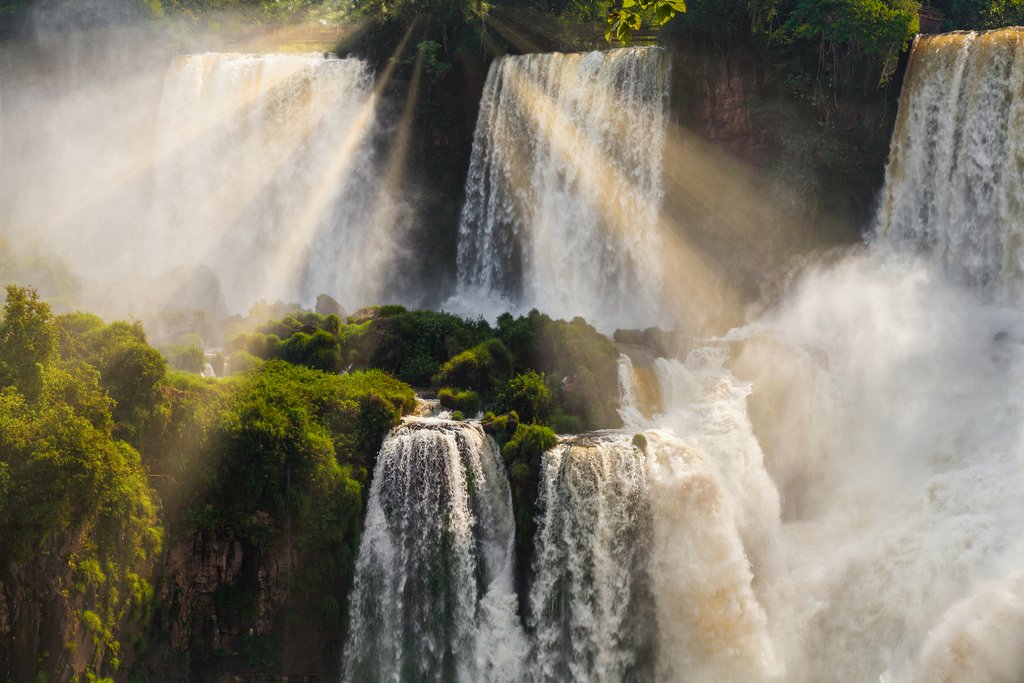Weather
Northern Argentina and southern Brazil, where the waterfalls are located, get very hot and humid in January. Expect temperatures in the low 80s through high 90s during the day—and it doesn’t cool off much after dark, thanks in part to the high humidity. On the other hand, you’re not particularly likely to experience rainy days at this time of year (save for summer storms that usually pass through quickly) and most of the national parks’ trails are shaded by the surrounding forest, keeping hikers relatively cool.
Crowds & Costs
January is one of the busiest times to visit Iguazú: it’s summertime in Argentina and Brazil, so many families go on vacation in their own countries, and many travelers from the US and Europe come at this time of year, too, escaping the cold at home.
Book flights and accommodations well ahead of time, and prepare to wait in line at ticket counters, restaurants, the airport, and the parking lots at both national parks.
What To Do
Since the sun is intense in January, stay in the shade by hiking on forest trails on both sides of the border (stopping for photo ops at lookout points like Garganta del Diablo, but not lingering too long in the direct sun!) Take advantage of the trains that transport you around the park, and make sure to bring plenty of water.
January is a great time for water sports on the rivers in the region, not to mention the boat ride that takes you to the base of the falls on the Argentine side: you’ll get wet, and that’s part of the appeal.
Chat with a local specialist who can help organize your trip.
What To Look For
The river is at its highest level in summer, so expect to see extra-powerful cascades of water pouring over the cliffs of Iguazú: be sure to keep close watch over children and use caution when walking on slippery catwalks around the falls.
Indigenous to the jungles around Iguazú, the Yaguareté (jaguar) is one of the largest cats on the globe. It would be rare, though not impossible, to spot one walking through the forest—they also climb trees and swim in the river. Easier to spot in the wild are several varieties of toucans: just look up in the trees for their colorful beaks.
Events & Activities
New Year's Eve & New Year's Day: The parks are open and while some businesses close, particularly on New Year's Day, many stay open for the influx of tourists in town. You'll see celebrations popping up at hotels, restaurants, and bars on both sides of the border, especially in Puerto Iguazú.
Walks in the Moonlight: Five nights a month, depending on the lunar calendar, Iguazú National Park offers guided nocturnal tours where you can see the park’s best attractions under the moonlight. Several departures are available (7:45, 8:30, and 9:15 pm) and reservations are required.
Visiting Iguazú Falls in January? Check out these great itinerary options.
Buenos Aires & Iguazú Falls - 6 Days Stroll through Buenos Aires' eclectic neighborhoods before visiting the breathtaking Iguazu Falls National Park in this short but sweet itinerary that balances culture with nature.
Ultimate Iguazú Falls Experience - 4 Days This four-day getaway to Iguazú Falls takes you into the heart of one of Argentina’s most prized destinations. Then, you'll experience another side of the falls from Brazil, with expansive, panoramic views.
More Helpful Information
Ultimate Guide to Iguazú National Park
Argentina in January
Argentina Tours & Itineraries
Iguazú Falls in December
Iguazú Falls in February
